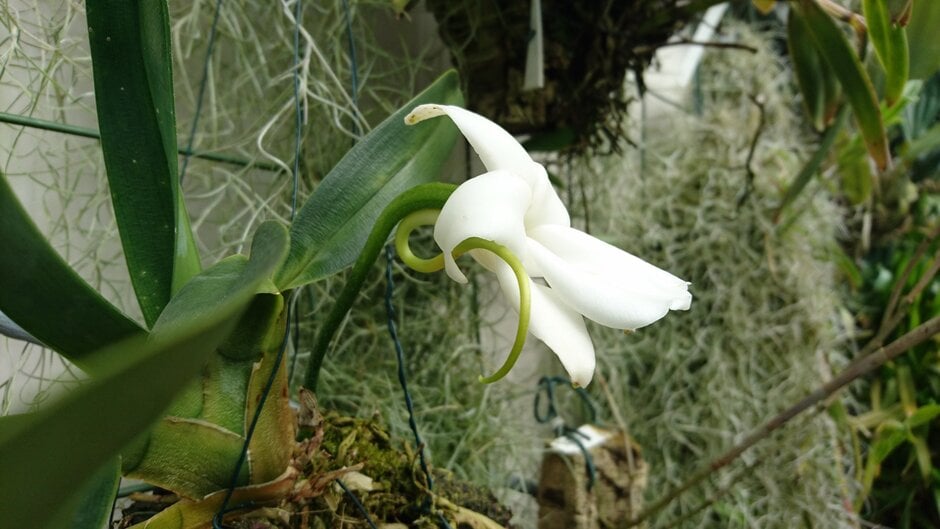Angraecum sororium
A cool-growing orchid forming clumps of upright stems with 2 rows of stiff, strap-shaped shiny green leaves. The plant is found growing in habitat among boulders and rocks and decaying leaf litter, in the highlands of central Madagascar, often in almost full sun, although this is mediated by frequent fog and mists. Up to 4 waxy, moderately long lasting, white flowers, with a green spur-like nectary, are produced on a single flower stem from January to March, and are spicily night scented

Size
Ultimate height
0.5–1 metresTime to ultimate height
5–10 yearsUltimate spread
0.1–0.5 metresGrowing conditions
Moisture
Moist but well–drainedpH
NeutralColour & scent
| Stem | Flower | Foliage | Fruit | |
| Spring | White | Green | ||
|---|---|---|---|---|
| Summer | ||||
| Autumn | Green | |||
| Winter | White | Green |
Position
- Full sun
- Partial shade
Aspect
East–facing or North–facing or South–facing or West–facing
Exposure
Sheltered Hardiness
H2Botanical details
- Family
- Orchidaceae
- Native to GB / Ireland
- No
- Foliage
- Evergreen
- Habit
- Clump forming, Columnar upright
- Name status
Correct
- Plant range
- Central highlands of Madagascar
How to grow
Cultivation
Grow in an open, well drained but moisture-retentive mix which can include, lava rock or pumice, fine fir bark and leafmold or chopped sphagnum moss. Provide the brightest light possible without risking scorching the plant’s leaves. Prefers a minimum night temperature of 12°C and a maximum of 25°C in the daytime. Night time temperatures should be 10°C lower than daytime temperatures for good growth and is beneficial to induce flowering. High humidity is required along with good air movement. Allow plants to freely drain when watering and avoid plants sitting in water as this can cause roots to rot. Plants may be intolerant of hard tap water, so irrigate with rainwater at room temperature. Orchid fertiliser can be applied regularly throughout the growing season, March to September. Reduce watering and feeding in winter months. See indoor orchid cultivation for further advice
Propagation
Propagation by seed is only possible in a controlled laboratory environment. Mature plants that have produced multiple stems may be divided when the plant overgrows its container. . Use a sterilized blade and ensure divisions have their own roots
Suggested planting locations and garden types
- Conservatory and greenhouse
Pruning
No pruning required apart from the removal of faded flowers
Pests
May be susceptible to mealybugs and scale insects infestations
Diseases
Generally disease-free
Get involved
The RHS is the UK’s gardening charity, helping people and plants to grow - nurturing a healthier, happier world, one person and one plant at a time.